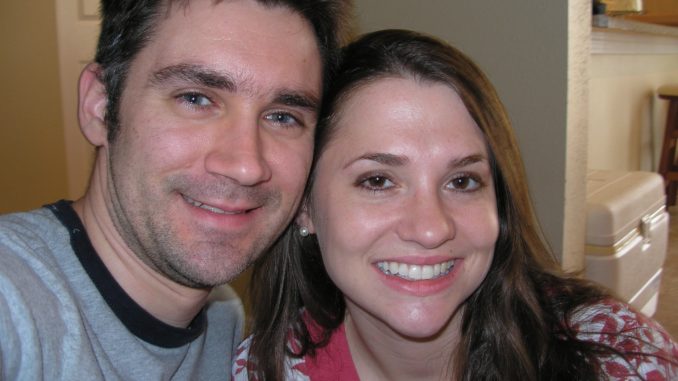
Local author acts to raise awareness about diabetes, a disease his wife faces everyday
Local science fiction writer Lee Hebert is helping raise diabetes awareness by donating 60 percent of the book sales from his Epic novel series for the month of November to the Juvenile Diabetes Research Foundation. Hebert, who’s wife was diagnosed with type 1 diabetes at the age of 16, says that his reasons for supporting the organization are simple and come straight from the heart.
“It’s impossible to understand the effects of diabetes on someone unless you’re there to witness it first hand,” he said. “My wife, Lindsey, really opened my eyes to the reality of this disease. And if I can use my writing to help promote such an important cause, it would be truly a blessing. I love my wife. I want to see her and every diabetic cured.”
Type 1 diabetes is an autoimmune disease that primarily affects young people, with diagnoses taking place from infancy to young adulthood. It is different from type 2 diabetes in that it renders the victim insulin-dependent for life.
The affected person’s pancreas stops secreting insulin altogether, whereas in type 2 diabetes, the pancreas continues to secrete insulin.
“This affects children and young adults by forcing them to take insulin injections, check blood sugars with a ‘fingerstick’ multiple times a day and constantly manage the ‘highs’ and ‘lows’ that are a part of everyday life,” said Lindsey.
Diabetes also has long-term consequences as well. It is the leading cause of blindness and affects all the major organs, including causing peripheral nerve damage referred to a neuropathy, It can result in amputations, kidney disease and even death.
“The hardest obstacle I had to face with diabetes was my initial diagnosis,” said Lindsey. “It had a great impact emotionally on me. I think that when anyone is diagnosed with a chronic illness, it’s hard to accept.”
Lindsey, who is also a diabetes liaison at Children’s Hospital, says that she wasn’t able to face her disease with positivity until she actually accepted the disease as a permanent fixture in her life.
“I decided that the best way to help myself is by helping others,” she said. “It gives me motivation to take better care of myself so that I can be a good role model to others, especially children and teenagers.
“Since I have experienced the stress, grief and anger associated with such a diagnosis at a young age, it enables me to empathize with young people experiencing the same emotions. If I can give others hope, then I have a reason to hope myself.”
Lindsey points out that type 1 diabetes is merely treated with insulin – there is no cure.
“Some people make take two injections daily, multiple daily injections or more aggressive forms of treatment such as insulin pump therapy,” she said. “I have worn an insulin pump to manage my diabetes for the last six years.”
The pump is a device that Lindsey changes out approximately every three days. It allows her to receive a small amount of insulin every hour.
“I still have to count carbohydrates whenever I eat and give myself the correct amount of insulin,” said Lindsey. “Life with diabetes is a constant struggle to manage food choices, exercise or activity levels, and blood sugars.”
And all of those factors can be affected by numerous things such as fluctuating hormone levels, sickness and any change made to a diabetic’s routine – a routine that Lee has witnessed first hand.
“Like most people, I was unaware of the intricacies of this disease until I saw how it affected the person I love the most,” he said. “As the husband of a type-1 diabetic, I witness the challenges my wife faces on a daily basis.
“Terms like ‘having a high’ and ‘suffering a low’ have become part of my permanent lexicon. I have been introduced to a world of needles, insulin pumps and blood glucose meters. Experiencing her struggles and her triumphs has shown me just how much I take for granted.”
Lee says that he and Lindsey’s goal is to bring attention to diabetes through literature and to implore people to consider donating to the JDRF during the month that has been designated as National Diabetes Awareness Month.
“Because of the JDRF, diabetics have a network of international support and an organization dedicated to confronting and conquering this disease,” he said. “Diabetes is a devastating disease, but one we are on the brink of curing.
“Please join us in this effort to raise awareness and make a difference. No amount is too small or too large – every bit goes toward finding a cure.”
There are two ways to donate.
First, you can go to www.jdrf.org and donate on the JDRF’s fight for a cure personally. Just click on the “donate now” tab located at the top-right of the menu.
You can give any amount you wish as either a one-time donation or a monthly commitment.
The second way to donate is to visit www.epicuniverse.com and purchase one of the books found in Lee’s Epic series. As previously mentioned, 60 percent of this month’s sales will go directly to the JDRF.
“If you know someone who might be interested in the Epic series, there is no better month than this one to get them to jump on board,” said Lee.
“They will be joining a good cause and discovering a new science fiction series at the same time.”
The Diabetes Dictionary
• Type 1 (insulin-dependent or juvenile) – Type 1 diabetes (juvenile diabetes) can occur at any age, but most commonly is diagnosed from infancy to the late 30s. In this type of diabetes, a person’s pancreas produces little or no insulin. Although the causes are not entirely known, scientists believe the body’s own defense system (the immune system) attacks and destroys the insulin-producing cells in the pancreas. People with type 1 diabetes must inject insulin several times every day.
• Type 2 (non-insulin-dependent or adult-onset) – Type 2 diabetes typically develops after age 40, but can appear earlier, and has more recently begun to appear with more frequency in children. In this form of diabetes the pancreas still produces insulin, but the body does not produce enough or is not able to use it effectively. Treatment includes diet control, exercise, self-monitoring of blood glucose and, in some cases, oral drugs or insulin.
• Monogenic Diabetes – Type 1 and 2 diabetes are polygenic diseases, meaning the risk of developing these forms of diabetes is related to multiple genes. But some rare forms of diabetes result from mutations in a single gene and are called monogenic; they are sometimes mistaken for type 1.
• Gestational Diabetes – About 2 to 5 percent of pregnant women develop high blood sugar during pregnancy. Although this type of diabetes usually disappears after the birth of the baby, women who have had gestational diabetes are at high risk of developing type 2 diabetes later in life.




Be the first to comment